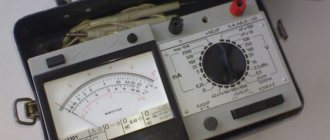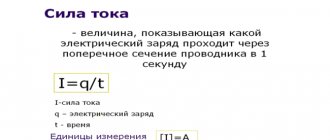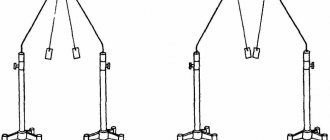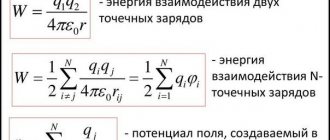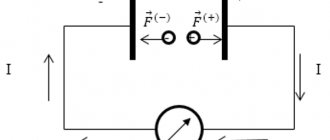Home Online textbooks Database of Russian tutors Physics simulators Preparation for the Unified State Exam 2022 online
Chapter 1. Electrodynamics
Many physical phenomena observed in nature and the life around us cannot be explained only on the basis of the laws of mechanics, molecular kinetic theory and thermodynamics. These phenomena manifest forces acting between bodies at a distance, and these forces do not depend on the masses of the interacting bodies and, therefore, are not gravitational. These forces are called electromagnetic forces.
The ancient Greeks knew about the existence of electromagnetic forces. But the systematic, quantitative study of physical phenomena in which the electromagnetic interaction of bodies is manifested began only at the end of the 18th century. Through the work of many scientists in the 19th century, the creation of a harmonious science studying electrical and magnetic phenomena was completed. This science, which is one of the most important branches of physics, is called electrodynamics.
The main objects of study in electrodynamics are electric and magnetic fields created by electric charges and currents.
1.1. Electric charge. Coulomb's law
Like the concept of gravitational mass of a body in Newtonian mechanics, the concept of charge in electrodynamics is the primary, basic concept.
Electric charge is a physical quantity that characterizes the property of particles or bodies to enter into electromagnetic force interactions.
Electric charge is usually denoted by the letters q or Q.
The totality of all known experimental facts allows us to draw the following conclusions:
- There are two types of electric charges, conventionally called positive and negative.
- Charges can be transferred (for example, by direct contact) from one body to another. Unlike body mass, electric charge is not an integral characteristic of a given body. The same body under different conditions can have a different charge.
- Like charges repel, unlike charges attract. This also reveals the fundamental difference between electromagnetic forces and gravitational ones. Gravitational forces are always attractive forces.
One of the fundamental laws of nature is the experimentally established law of conservation of electric charge.
In an isolated system, the algebraic sum of the charges of all bodies remains constant:
| q1 + q2 + q3 + … +qn = const. |
The law of conservation of electric charge states that in a closed system of bodies processes of creation or disappearance of charges of only one sign cannot be observed.
From a modern point of view, charge carriers are elementary particles. All ordinary bodies are composed of atoms, which include positively charged protons, negatively charged electrons and neutral particles - neutrons. Protons and neutrons are part of atomic nuclei, electrons form the electron shell of atoms. The electric charges of a proton and an electron are exactly the same in magnitude and equal to the elementary charge e.
In a neutral atom, the number of protons in the nucleus is equal to the number of electrons in the shell. This number is called the atomic number. An atom of a given substance may lose one or more electrons or gain an extra electron. In these cases, the neutral atom turns into a positively or negatively charged ion.
Charge can be transferred from one body to another only in portions containing an integer number of elementary charges. Thus, the electric charge of a body is a discrete quantity:
Physical quantities that can only take a discrete series of values are called quantized. Elementary charge e is a quantum (smallest portion) of electric charge. It should be noted that in modern physics of elementary particles the existence of so-called quarks is assumed - particles with a fractional charge and However, quarks have not yet been observed in a free state.
In ordinary laboratory experiments, an electrometer is used to detect and measure electrical charges - a device consisting of a metal rod and a pointer that can rotate around a horizontal axis (Fig. 1.1.1). The arrow rod is isolated from the metal body. When a charged body comes into contact with the electrometer rod, electric charges of the same sign are distributed over the rod and the pointer. Electrical repulsion forces cause the needle to rotate through a certain angle, by which one can judge the charge transferred to the electrometer rod.
| Figure 1.1.1. Transfer of charge from a charged body to an electrometer |
The electrometer is a rather crude instrument; it does not allow one to study the forces of interaction between charges. The law of interaction of stationary charges was first discovered by the French physicist C. Coulomb in 1785. In his experiments, Coulomb measured the forces of attraction and repulsion of charged balls using a device he designed - a torsion balance (Fig. 1.1.2), which was distinguished by extremely high sensitivity. For example, the balance beam was rotated by 1° under the influence of a force of the order of 10–9 N.
The idea of the measurements was based on Coulomb's brilliant guess that if a charged ball is brought into contact with exactly the same uncharged one, then the charge of the first will be divided equally between them. Thus, a way was indicated to change the charge of the ball by two, three, etc. times. In Coulomb's experiments, the interaction between balls whose dimensions were much smaller than the distance between them was measured. Such charged bodies are usually called point charges.
A point charge is a charged body whose dimensions can be neglected in the conditions of this problem.
| Figure 1.1.2. Coulomb device |
| Figure 1.1.3. Interaction forces between like and unlike charges |
Based on numerous experiments, Coulomb established the following law:
The interaction forces between stationary charges are directly proportional to the product of the charge moduli and inversely proportional to the square of the distance between them:
Interaction forces obey Newton's third law: They are repulsive forces with the same signs of charges and attractive forces with different signs (Fig. 1.1.3). The interaction of stationary electric charges is called electrostatic or Coulomb interaction. The branch of electrodynamics that studies the Coulomb interaction is called electrostatics.
Coulomb's law is valid for point charged bodies. In practice, Coulomb's law is well satisfied if the sizes of charged bodies are much smaller than the distance between them.
The proportionality coefficient k in Coulomb's law depends on the choice of system of units. In the International SI system, the unit of charge is the coulomb (C).
A coulomb is a charge passing through the cross section of a conductor in 1 s at a current of 1 A. The unit of current (ampere) in SI is, along with units of length, time and mass, the basic unit of measurement.
The coefficient k in the SI system is usually written as:
where is the electrical constant.
In the SI system, the elementary charge e is equal to:
| e = 1.602177·10–19 C ≈ 1.6·10–19 C. |
Experience shows that the Coulomb interaction forces obey the principle of superposition.
If a charged body interacts simultaneously with several charged bodies, then the resulting force acting on a given body is equal to the vector sum of the forces acting on this body from all other charged bodies.
Rice. 1.1.4 explains the principle of superposition using the example of the electrostatic interaction of three charged bodies.
| Figure 1.1.4. The principle of superposition of electrostatic forces |
| Model. Interaction of point charges |
The principle of superposition is a fundamental law of nature. However, its use requires some caution when we are talking about the interaction of charged bodies of finite sizes (for example, two conducting charged balls 1 and 2). If a third charged ball is brought to a system of two charged balls, then the interaction between 1 and 2 will change due to the redistribution of charges.
The principle of superposition states that for a given (fixed) distribution of charges on all bodies, the forces of electrostatic interaction between any two bodies do not depend on the presence of other charged bodies.
Electrostatic field of a charged sphere
Direction of the lines of force of the electrostatic field of a charged sphere:
| Positively charged sphere +Q | Negatively charged sphere –Q |
| For a positively charged sphere, the field lines are radial lines that start from this sphere. | For a negatively charged sphere, the field lines are radial lines that end in that sphere. |
Electrostatic field strength modulus of a charged sphere:
| Inside the conductor (the distance is less than the radius of the sphere, or r E = 0 a - the distance from the surface of the sphere to the point being studied. r - the distance from the center of the sphere to the point being studied. |
Coulomb force:
Example No. 2. Determine the potential of the electrostatic field created by a charged sphere with a radius of 0.1 m at a point located at a distance of 0.2 m from this sphere. The sphere is positively charged and has a charge of 6 nC.
Since the sphere is positively charged, the potential is also positive:
Two stationary point charges act on each other with forces whose modulus is equal to F. What will the modulus of these forces be equal to if one charge is increased by n times, the other charge is reduced by n times, and the distance between them remains the same?
Solution algorithm
Solution
Let's write down the initial data:
Let's apply Coulomb's law to pairs of charges. Coulomb's law for the first pair:
Coulomb's law for the second pair:
The coefficient n has decreased. Consequently, the forces with which the charges interact with each other will not change:
After changing the charges, the modulus of the interaction force between them will remain equal to F.
analyzed by: Alisa Nikitina | discuss analysis | estimate
Point charges are placed at the three vertices of the square: +q, – «>– q, +q (q >0) (see figure). Where is the Coulomb force directed, acting from these charges on the point charge +2q located in the center of the square?
Solution algorithm
Solution
Let's make a drawing. A positive charge is placed in the center. It will be repelled by positive charges and attracted to negative ones:
The moduli of all force vectors applied to the central point charge are equal, since the moduli of the point charges located at the vertices of the square are equal, and they are located at the same distance from this charge.
Adding the vectors geometrically, we will see that the forces with which the charge +2q repels from the point charges +q cancel each other out. Therefore, the charge is subject to a resultant force equal to the force with which it is attracted to the negative point charge –q. This force is directed in the same direction (towards the lower right vertex of the square).
analyzed by: Alisa Nikitina | discuss analysis | estimate
There is a charge Q on a stationary conducting solitary ball of radius R. Point O is the center of the ball, OA = 3R/4, OB = 3R, OC = 3R/2. The modulus of the electrostatic field strength of the charge Q at point C is equal to EC. Determine the modulus of the electrostatic field strength of the charge Q at point A and point B?
Establish a correspondence between physical quantities and their meanings.
For each position in the first column, select the corresponding position in the second and write down the selected numbers in the table under the corresponding letters.
Source
Tension lines
The electric field cannot be seen with the naked eye, but can be depicted using tension lines. Graphically, these will be continuous straight lines that connect charged objects. The conventional starting point of such a straight line is on a positive charge, and the end point is on a negative charge.
Tension lines are straight lines that coincide with the lines of force in a system of positive and negative charges. The tangents to them at each point of the electric field have the same direction as the strength of this field.
When graphically depicting lines of force, it is possible to convey not only the direction, but also the magnitude of the electric field strength (of course, conditionally). In places where the modulus of tension is higher, it is customary to make a denser pattern of lines. There are also cases when the density of lines does not change - this happens when depicting a uniform field.
A uniform electric field is created by opposite charges with the same module located on two metal plates. The tension lines between these charges are parallel straight lines everywhere, with the exception of the edges of the plates and the space behind them.
Source
Units of measurement and formulas
From the above definition it is clear how to find the electric field strength at a certain point:
E = F / q , where F is the force acting on the charge, and q is the magnitude of the charge located at a given point.
If we need to express force in terms of tension, we get the following formula:
F = q × E
The direction of the electric field intensity always coincides with the direction of the acting force. If we take a negative point charge, the formulas will work similarly.
Since force is measured in newtons and charge is measured in coulombs, the unit of electric field strength is N/C (newton per coulomb).
Superposition principle
Let's say we have several charges that cross-interact and form a common field. What is the strength of the electric field created by these charges?
It was found that the total force acting on a specific charge located in a field is the sum of the forces acting on a given charge from each body. It follows from this that the field strength at any given point can be calculated by summing the voltages created by each charge separately at the same point (taking into account the vector). This is the principle of superposition.
This rule is correct for any fields, with some exceptions. The principle of superposition is not observed in the following cases:
We are talking about super-strong fields with a intensity of more than 10 20 V/m.
But problems with such data go beyond the scope of a school physics course.
